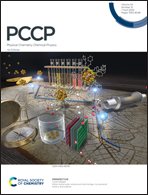First-principles calculations of the BeO monolayer with chemical functionalization†
Abstract
Recently, extensive experimental and theoretical studies on two-dimensional materials have attracted enormous interest in exploring the properties of these materials by decorating their surfaces. In the present work, we present a detailed investigation of the structures, and electronic and magnetic properties of pristine, hydrogenated, and fluorinated BeO monolayers using the ab initio density functional theory approach. Structurally, the most stable adsorption sites are directly above the host Be atom for half-hydrogenation, above the middle of the Be–O bond for half-fluorination, and directly above the host Be atom and below the host O atom for full-hydrogenation and full-fluorination. Moreover, the electronic and magnetic properties of the BeO monolayer exhibit high sensitivity to chemical functionalization: half-hydrogenation induces nonmagnetic–magnetic transition and the reduction of the band gap reaches about 75%. Full-hydrogenation results in metallization of the BeO monolayer. Half-fluorination makes the BeO monolayer a 100% spin polarized material regardless of the adsorption site. However, depending on different adsorption sites, full-fluorination can produce either magnetically half-metallic or nonmagnetic semiconductor structures. These results demonstrate that the tunability of the electronic and magnetic properties of the BeO monolayer can be realized by chemical functionalization for future nano-electronic and spintronic device applications.



 Please wait while we load your content...
Please wait while we load your content...